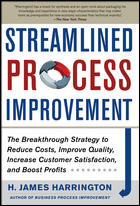Almost all organizations set performance targets for departments and/or individuals to conduct their operations and to deliver products and services to their customers. Although managers attempt to ensure their processes can handle all the issues that may arise in their business, in today’s complex world, these processes often fall short.
Not surprisingly, when results do not meet targets, most organizations tend to blame people. This is sometimes done by asking what people should be doing better or wanting to know who did not do what needed to be done.
Studies tend to show that focusing on what people can do better to enhance performance often results in short-term improvement, but with diminishing returns. Eventually people run out of ideas and repeated discussion about failed targets can demoralize even the most loyal employees.
Experts, like the late quality giants Drs. Joseph M. Juran and W. Edwards Deming, stress that 85-94% of the time, the problem turns out to be management’s, or the management systems’, fault. The established processes in place are not up to the task of handling today’s business climate. Additionally, the management structure has not adequately empowered the organization to continuously improve.
The most successful organizations, however, have managers who have been trained or understand that the problem is not people failing to deliver, but that it is their organizational processes that are not up to the challenge. They realize that it is the processes that need to be improved. This is where management focuses their continuous-improvement efforts, and enlightened managers encourage the organization to identify shortcomings.
If any organization really desires to improve their business, they must celebrate mistakes that result from inadequate systems so they can be analyzed and corrected. Enlightened organizations do not seek someone to blame for the problem. Enlightened organizations have their sensors turned up to identify problems that will inevitably arise and encourage their people to expose these issues rather than try to cover them up.
In organizations where people are blamed for negative variances, there is a culture of “hide it and protect yourself” to guard against blame. There must be a culture of exposing process variations to prevent future occurrences of the same issue. In a blame culture, these variances from expected results will continue to occur, and the people will continue to bury the issues whenever possible rather than exposing them so they can be fixed permanently.
In one company the senior manager’s monthly metrics meeting typically involved placing blame and arguments when targets were not met. No one wanted to attend these meetings. After studying the issue, the senior quality engineer, in charge of creating the metric charts, added statistical control limits to the charts. Immediately the senior management, who understood the concept of variation, understood that variation also affected business metrics. These meetings transformed into sessions devoted to reducing process variation and the atmosphere became conducive to continuous improvement.
Organizations must adopt a culture that encourages people to elevate process issues when they arise rather than trying to hide them. Managers must treat variances from expected process results as valuable pearls of opportunity that allow improvement instead of costly errors that “somebody” made. Managers have to ask themselves, “What do I want in my business? Do I want a culture of blame or one of problem resolution using continuous-improvement teams?”
The successful organizations take the latter path and constantly work to identify problems. Instead of asking employees what they can do better, managers should ask them how the organization can make the process better so the outcome is more predictable with less variation. Focus should be on the process, not on the people. If a process works well and makes sense in the context of people’s work, employees will function well within it.
Most people will contribute to positive outcomes if given a proper environment to do so. It is far more productive to focus on streamlining processes or systems and making them better rather than trying to get good people to work within a less than adequate process or system. The earlier scenario is motivating while the latter is demoralizing.
Constantly striving to identify the shortcomings in business processes and then having the entire workforce engaged and motivated to continuously improve them will go a long way to ensure your business is a standout success.
The quality professional is in a unique position to help their organizations create a vibrant continuous-improvement culture.









